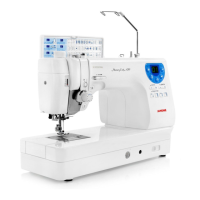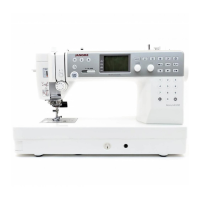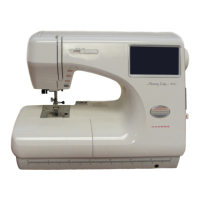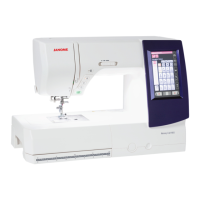Why are layers shifting when I sew with my Janome Sewing Machine?
- SSean WalkerSep 14, 2025
If layers are shifting when you sew with your Janome sewing machine, adjust the foot pressure to suit the fabrics being sewn.

Why are layers shifting when I sew with my Janome Sewing Machine?
If layers are shifting when you sew with your Janome sewing machine, adjust the foot pressure to suit the fabrics being sewn.
| Type | Computerized Sewing Machine |
|---|---|
| Stitch Options | 30 |
| Maximum Stitch Width | 7 mm |
| Maximum Stitch Length | 5 mm |
| Needle Positions | 91 |
| Speed | 1000 stitches per minute |
| Weight | 14.3 lbs (6.5 kg) |
| Stitch Count | 30 |
| Needle Threader | Yes |
| Stitch Width | 7 mm |
| Stitch Length | 5 mm |
| LCD Screen | Yes |
| Speed Control | Yes |
| Free Arm | Yes |
| Bobbin Type | Top Loading |
| Included Accessories | needles, bobbins |
| Stitches | 30 |
Instructions to reduce the risk of electric shock, including unplugging and bulb safety.
Warnings regarding burns, fire, injury, intended use, ventilation, and avoiding outdoor use.
Guidelines for safe operation, focusing on attention to moving parts and proper machine handling.
Details the names and functions of various parts of the sewing machine.
Lists and describes the included accessories for the sewing machine.
Steps for connecting power, using the speed control lever, and the foot control.
Detailed explanation of function buttons like thread cutter, needle up/down, auto-lock, and reverse.
Instructions for operating the presser foot lifter, knee lifter, and attaching different feet.
Details the uses of various presser feet for different sewing tasks.
Step-by-step guide for changing and attaching/detaching presser feet and foot holders.
Guides for attaching specific presser feet like the even feed and darning foot.
Procedures for removing the bobbin and setting up the spool of thread for winding.
Step-by-step instructions for winding the bobbin using the bobbin winder.
Step-by-step instructions for correctly inserting the bobbin into the bobbin holder.
Detailed steps for threading the sewing machine, including guides and levers.
Details on threading through tension disks and the take-up lever.
Instructions for using the automatic needle threader for easier threading.
Procedure for drawing up the bobbin thread to prepare for sewing.
Guidelines for changing needles and a chart correlating fabrics with appropriate needle types.
Information on balancing thread tension for ideal stitch quality.
Instructions on adjusting foot pressure and dropping the feed dog for specific sewing tasks.
Instructions for sewing a straight stitch, including starting points and edge sewing.
Methods for securing seams using reverse stitches and automatic locking stitches.
Techniques for changing sewing direction and using cloth and seam guides.
How to adjust the needle drop position and stitch length using control buttons.
Details on different straight stitches like Lock-a-Matic and Triple Stretch stitches.
Instructions for using the basting stitch to hold fabric layers together temporarily.
How to use the zigzag stitch for various sewing needs and adjust its width and length.
Using zigzag, overcasting, and overlock stitches to finish fabric edges.
Instructions for multiple zigzag (Tricot) and knit stitches for fabric finishing.
Step-by-step guide for preparing fabric and sewing zippers using the zipper foot.
Detailed steps for sewing zippers, including folding, basting, and stitching.
Final steps for zipper sewing, including closing, basting tape, and removing basting stitches.
Techniques for sewing rolled hems and shell tucks using specific presser feet.
How to fold fabric and sew blind hems, including needle drop adjustment.
Introduces sensor, automatic, keyhole, and stretch buttonholes with their applications.
Step-by-step guide for sewing sensor buttonholes using the automatic buttonhole foot.
Detailed steps for sewing automatic buttonholes, including starting and stopping the machine.
Instructions for sewing double layer and corded buttonholes for enhanced durability and appearance.
How to adjust buttonhole width and stitch density for desired results.
Steps for sewing automatic buttonholes, including width and density adjustments.
The sequence of sewing automatic buttonholes and how to sew multiple buttonholes.
Instructions for sewing buttons onto fabric using the satin stitch foot and dropping the feed dog.
How to perform darning to repair rips or holes in fabric using specific settings.
Techniques for sewing shorter darning, adjusting darning size, and correcting evenness.
Using the tacking stitch to reinforce areas like pockets and belt carriers for strength.
How to sew eyelets for belt holes and adjust their shape for proper gap or overlap.
Using the 1/4" seam foot for precise patchwork seams and angle scales for alignment.
How to sew patchwork stitches along seam lines for decorative finishes.
Using a quilting bar with zigzag foot and performing freemotion quilting with darning foot.
Binding thick quilt layers together using the clasp stitch with memory function.
Steps to program and sew a sequence of patterns, including using memory and auto-lock functions.
How to start sewing programmed pattern combinations from the beginning.
Combining patterns with automatic thread cutting for efficient sewing.
How to elongate specific patterns to increase their length while maintaining stitch density.
Instructions for creating open work with fagoting and gathering fabric for smocking.
Guidance on sewing appliques using satin stitch and an open toe foot.
Introduction to twin needle sewing, including setup, threading, and button selection.
How to sew with a twin needle, including speed and direction changes, and pattern suitability.
Adjusting stitch length and width uniformly for programmed patterns.
Adjusting stitch length and width for individual patterns within a programmed combination.
Using the feed balancing dial to correct distortions in stretch stitches and auto buttonholes.
Adjusting the tacking stitch timing using the feed balancing dial.
How to review programmed pattern combinations and delete individual patterns.
Steps to insert new patterns into a programmed combination or duplicate existing ones.
Detailed steps for cleaning the hook race, feed dog, and related mechanisms to maintain performance.
Instructions for correctly reassembling the hook race and bobbin holder after cleaning.
Guide on how to safely remove and replace the sewing machine's light bulb.
Explains common warning signs displayed on the LCD screen and how to resolve them.
Interpreting LED blink patterns and audible buzzer signals for machine status and errors.
A table listing common sewing issues, their causes, and suggested solutions with page references.











